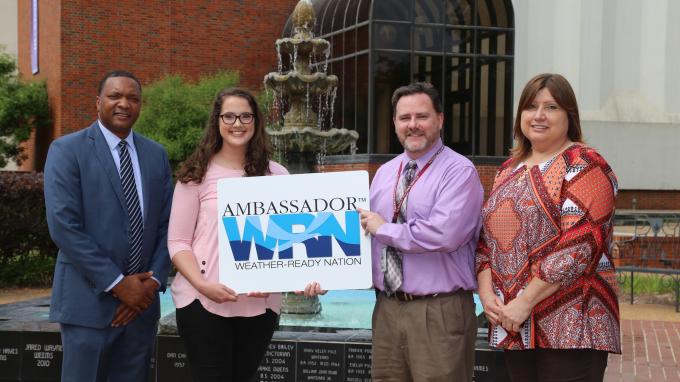EHS Officer named Ambassador for Weather Ready Nation
NATCHITOCHES – The National Weather Service (NWS) recognized Northwestern State University as StormReady® Tuesday and named Health and Environmental Safety Officer Julie Powell an Ambassador with the Weather Ready Nation through the NWS.
“NSU is concerned with the safety of our students, faculty, staff and visitors. One way we assist in promoting safety is by becoming a StormReady University,” said Marcus Jones, executive vice president for University and Business Affairs. “In the event of severe weather, EHS Officer Julie Powell will work with the National Weather Service for early detection and early notification.”
Earlier this year, 15 faculty/staff members toured the National Weather Service facility to get an idea of how severe weather is identified and broadcast. NSU personnel participate in a weekly weather briefing performed by the NWS.
“When conditions warrant, we share information via Facebook/NSU Student Concerns and Purple Alert,” Jones said. “Additionally, we will host a National Weather Service Skywarn class this summer for the Natchitoches community and surrounding areas. Everyone is invited to attend, including students.”
“Northcentral Louisiana experiences very active severe weather episodes throughout the year,” said Charlie Woodrum, Warning Coordination Meteorologist of the National Weather Service Forecast Office in Shreveport. “Due to our geographic location, potentially deadly weather could impact Northwestern State University and Natchitoches Parish on any given day. In order to prepare for severe weather and keep its citizens safe, university staff members partnered with the NWS to meet the criteria required by the StormReady® program.”
Woodrum and Senior Meteorologist Jason Hansford presented the university with a recognition letter and a special StormReady® sign during a ceremony Tuesday.
The nationwide StormReady® community preparedness program uses a grassroots approach to help communities develop plans to handle local severe weather and flooding threats. The program is voluntary and provides communities with clear-cut advice from their local NWS forecast office as well as state and local emergency managers. StormReady® communities are better prepared to save lives from the onslaught of severe weather through better planning, education, and awareness. No community is storm proof, but StormReady® can help communities save lives.
To be recognized as StormReady®, a community or university must establish a 24-hour warning point and emergency operations center; have more than one way to receive severe weather forecasts and warnings and to alert the public; create a system that monitors local weather conditions; promote the importance of public readiness through community seminars; and develop a formal hazardous weather plan, which includes training severe weather spotters and holding emergency exercises.
“Today, there are more than 3,000 StormReady® communities,” Hansford said. “Northwestern State University joins the ranks of over 250 universities across the nation that have achieved StormReady® status, and only the third university in the state of Louisiana.”
Hansford added “The program is designed to help StormReady® communities improve communication and safety skills needed to save lives — before, during and after a severe weather event. The establishment of StormReady® universities are vital given the recent EF-3 tornado which tore through Louisiana Tech University in Ruston during the early morning hours of April 25.”
The StormReady® recognition will expire in three years, before which the university will go through a renewal process.
The NWS is the primary source of weather data, forecasts and warnings for the United States and its territories. It operates the most advanced weather and flood warning and forecast system in the world, helping to protect lives and property and enhance the national economy. Visit us online at weather.gov and on Facebook: http://www.facebook.com/NWS.
###
StormReady® is a registered trademark used by the National Oceanic and Atmospheric Administration.

